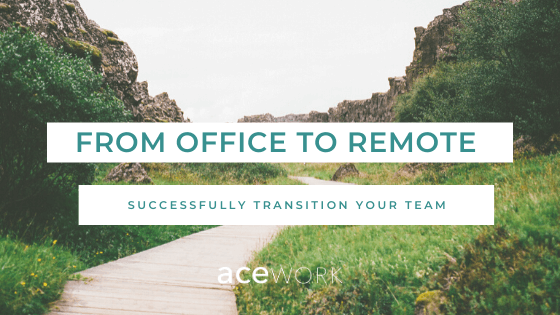Does your team still work together in an office? Is your definition of remote working basically answering emails or building presentations when you’re either at home or on business travel? You have no idea what a ‘remote-first’ or hybrid company is?
You’re not alone. Despite the recent increase in remote working, fact is, that most companies still consider the office their primary workplace. However, over the next couple of years, more and more “office companies” will have to become more flexible, hire new remote employees and allow their current ones to go remote. This will result in many partially remote, or hybrid, companies.
Taking the first step is easier than you may think. In addition to our own experience, we have spoken with Evelin Andrespok, People Operations Manager at Toggl about their transition from an office to a fully remote company.
What makes a hybrid company?
A hybrid company is one that is partially distributed. It will include a mix of both in-office workers and remote workers. One may argue that this is the best of both worlds. You still have a main base to leverage the power of face-to-face collaboration, while being flexible enough to include the most talented people in your team, no matter where they are located.
The main aspects of a hybrid company are:
- 1. The main team is located in one or several locations.
- 2. There are partially or fully remote employees who don’t work the office full-time or at all.
Toggl incorporates many different aspects of both traditional and remote work simultaneously. The time tracking software company still has its headquarters in Tallinn, Estonia; but have been partially distributed from early on. This hybrid model has helped the company to mitigate some common drawbacks teams can experience when trying to go remote.
Their team includes Tallinn-based employees with full flexibility, which means they can freely decide whether or not to come to the office. In addition, they work with fully remote team members around the world. The decision to reach out for talent across the globe wasn’t difficult for Toggl. Considering that talent acquisition is such a competitive field in Estonia, there is large potential in accessing the global talent pool.
What makes a fully remote company?
A fully remote company – also called FROG (Fully Remote OrGanisation) – has no permanent office and all employees work remotely. Since there is no traditional office space, this means no morning commute to work and no break room to chat with colleagues. The center of the workplace is not an office but inside applications such as Zoom, Slack and Gdrive.
The key elements are:
- 1. No office space – both, the postal address and legal address are virtual (watch our video with Kimberly from Olark to learn how to do this).
- 2. Everyone is remote – this means either working from home, a co-working space or travelling – the latter is commonly known as digital nomadism.
However, a successful hybrid company has adapted to this working style where all communication and processes are optimised for location-independent work. This means that even with one or several remaining offices, the ‘real’ workplace should be virtual. Companies that have managed to achieve this are also called ‘remote-first’.
Taking the first steps: How to transition to remote flexibility
For Toggl the decision to go remote from Estonia was not difficult considering the fierce competition for talent in the area. However, Evelin mentions that it was challenging for some employees to adapt to the flexible work environment.
Step 1: Do a test run with your existing employees
In the beginning, the leaders at Toggl decided to put one team to the test with one simple rule: they could not come to the office for a week. And yet, by Wednesday, some team members were unable to stay away. The main reason for their return seemed to be the lack of human interaction. Mainly in team meetings, but also during coffee breaks- the ‘chit chat’ creates personal bonds between coworkers. Since Toggle didn’t have places for virtual chit chat, employees felt like they were missing out.
Doing this exercise lets you figure out quickly what needs to be addressed in your remote working policy. It helps to pinpoint which structures and processes have to change. This also quickly draws out your employees’ concerns. Their buy-in is extremely important, so definitely follow up with the test group on their feedback.
Other issues to arise can include faulty communication processes leading to misunderstandings. Another possibility are technical difficulties when sharing information, collaborating or finding time to speak with each other. Every company will uncover individual points of friction that need to be addressed.
According to Evelin, after transitioning the company to remote-first, the lack of human interaction is no longer a problem. Actually, even the Tallinn-based employees are not using the office anymore. The initial steps to switch from an office to remote can be daunting and may take some getting used to, yet it is something that can be overcome.
Step 2: Define your Remote Work Policy and Processes
Another key element when testing remote flexibility is defining the company’s remote work policy. False expectations can be the downfall when transitioning your company, so the process needs to be clear.
A remote policy should essentially feature these points:
- Work Rate:
- – How remote workers will track their progress and results
- Communication and documentation:
- – Define fixed meeting times, standups, town hall meetings and all-hands.
- – Define which tools to use for which type of communication.
- – Develop documentation processes that allow for asynchronous communication across time zones. Great documentation is the ultimate productivity booster for remote teams.
- Availability:
- – Decide whether there are fixed or flexible working hours. For flexible hours, define core availability while taking into consideration the time zone differences of team members.
- Engagement and culture:
- – Finally, find ways to connect your team on issues that are outside of work: virtual coffee chats, watercooler channels, company retreats are all options, just to name a few.
Step 3: Begin Hiring Remotely
For Toggl, their first remote hire was a Cuban living in Spain. This first connection to a fully remote worker gave even more eye-opening insight into what it means to go remote.
Evelin says,
“The first time the Spanish guy came to visit us in Estonia it was really eye-opening for us after we spent some time with him. At first, he was just someone we knew online and through video calls, yet after we spent some time with him in real life we actually began to realise how cool it is to make friends globally and it really helped us make the switch.”
When hiring for remote roles, you need to take into consideration that remote working requires specific soft skills such as communication, self-motivation and discipline. At acework we call this “remote readiness” – and we have developed a vetting process for it. This way you do not have to screen every candidate for the same soft skills. Your focus should lie on testing whether the person can get the job done regarding their hard skills, and if their values and personality align with your company. Take a look at our conversation about company culture with Olark here.
Every candidate on the acework platform has successfully passed our remote readiness assessment, which makes recruiters’ lives easier and hiring faster.
To find the “needle in the haystack”, hiring processes for remote roles need to be well defined. Even with ensured ‘remote readiness’ through acework, you still need to find out if the person has the hard and soft skills for this specific role. In addition, you want to make sure this person will work well in your team (culture fit, values alignment, personality).
Job postings at acework allow you to include screening questions for all candidates. You can require candidates to answer either in written or video format. Both have proven highly useful to assess not only hard skills and expertise. At the same time you get an initial impression of the personality and mindset of the person.
Filtering out only the top candidates saves a lot of time and allows you to focus on interviewing high potentials only.
Finally, to really make sure this person is a great fit for your team, offer the last remaining 2-3 candidates a paid trial. This should last a few days and has to be compensated. It also means you should give them real tasks and let them collaborate with their future team.
Step 4: Prepare for Administrative Complexity
One reason many companies shy away from allowing remote working is the fear of creating administrative complexity that is too difficult to manage. On the other hand, some hybrid companies stay in this stage because they don’t know how to close their last remaining office.
When trying to go remote questions begin to crop up. For example, what about taxes and insurance? Can we hire employees in different countries? What does it mean to work with contractors long-term?
1. Payments
Luckily, there are a ton of resources today to help with the transition. For example, our partner Deel helps you hire contractors in other countries. Read more about hiring contractors here.
2. Health insurance
Health insurance can be a complex issue as well. If you want to insure your global team with one of the best health insurances out there, make sure to check out our partner SafetyWing. They’re getting ready to launch Norwegian healthcare for remote teams.
3. Mailing address vs legal address
When you decide to move from hybrid company to FROG, another question will come up: Where should our postal address be? If you still receive a lot of physical mail, it may be smart to use a virtual mailbox service. There are several providers in each country, for example Earth Class Mail in the US, UK Postbox in the UK, or Caya in Germany.
Every virtual mailbox can offer different services. These may include mail notification, shredding and disposal or check depositing. For most, the basic is access to online viewing which means you don’t have to be there to physically to open your mail.
Evelin points out that your legal address and postal address do not need to be the same. This means you can make sure your legal address is still close to the owners of the company, while you can have your mail handled elsewhere, if you prefer.
The key difference is that a postal address is just for your post as explained above, yet the legal address is the physical address. The distinction with this is that the legal address is related to a geographic location, like a street address. One aspect of this is as a basic SEO rule, your site should be linked to a physical address rather than a postbox for it to be recognised by the search engines properly. This address is also the one governed by an administrative authority which is used for collecting data. Knowing the difference can really help when deciding on which address to use and also what it would be utilised for.
For Toggl administrative issues aren’t an obstacle. Evelin says,
“We have our office space for the mail, and taxes are the same across the whole country, so registering Estonian employees in other cities isn’t causing complexity.”
What can YOU do to become remotely flexible?
For a company based in such a forward-thinking digital country such as Estonia, there seem to be no issues. It’s constantly ranked as the top country for digital workers and is third in Europe for the most start-ups per capita. Yet, not every country has the same perks or the same rules. Keep in mind, at least one remaining office helps you to avoid legal issues as a hybrid company. To keep hiring simple, focus on hiring employees in the country of the office. In addition, work with contractor agreements for people in foreign countries.
At acework we help companies to become ‘remote first’. If you like to chat, we are always curious to learn from other companies on the path to more flexibility at work. Get in touch and let us know your ideas and best practices (hello@acework.io).
If you want to get into a remote career or are looking for a new opportunity, use our Candidate Sign-up to join acework.






